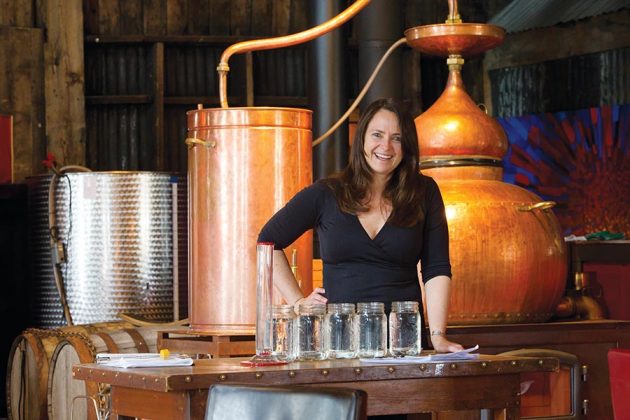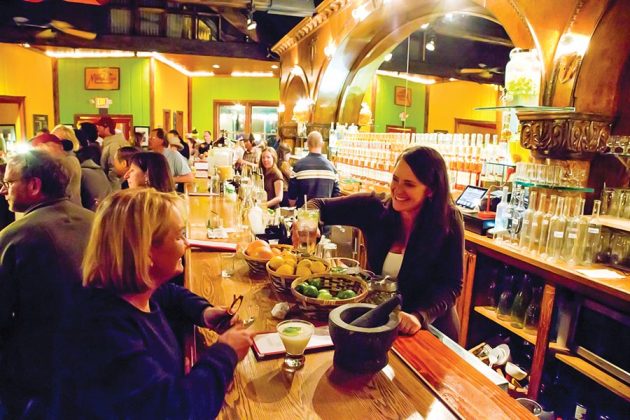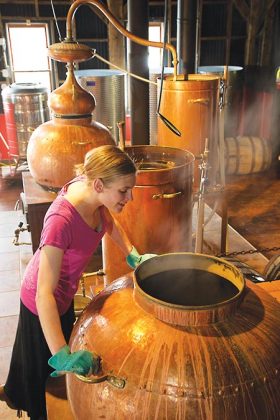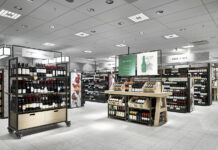In the 1880’s mining town of Crested Butte, known as the “official wildflower capital” of Colorado, is one of the country’s most successful rum distilleries: Montanya Distillers, which opened in 2008. President and distiller Karen Hoskin has crafted awarded-winning rums, garnering a list of honors that includes a 2010 Gold Medal in the San Francisco World Spirits Competition and being named one of the “Top 5 Best Rums in North America” by the UK’s Golden Rum Barrel Awards in 2010.
Montanya won a Silver Medal in the amber rum category in this year’s ADI’s 7th Annual Judging of Artisan American Spirits. During ADI’s 10th annual Spirits Conference in Denver this April, Montanya and Karen won the “Bubble Cap Award” 2013 Craft Distiller of the Year. ADI presents this award each year to a distiller that exemplifies excellence in craft distilling and growth as a business. Montanya Distillers is the second craft distillery in Colorado to receive the award, and the first female-owned company to be awarded.
In a recent Q&A session with Montanya President Karen Hoskin, we talk about the path that led her to distilling and rum, what it’s like to be a female in a male-dominated business, and keys to growing a successful business.
Congratulations on being named Distillery of the Year by receiving ADI’s Bubble Cap Award! What does it mean to you to be given this award?
There are a lot of different awards and distinctions out there in the spirits world, some legitimate and some not and everything in between. ADI is an organization that has really been central from the start of this craft-distilling phenomenon. It has really been the way distillers get to know each other, learn from and teach each other. So for Montanya to be distinguished in this group, among so many cool craft distillers, among our peers, is a huge honor for us. We still feel like newbies in this industry, but this was a great reminder that we’ve come a long way in the last 5 years and there are a lot more newbies looking to us now for inspiration.
How did you get into craft distilling?
Tell us your history.
I have been an entrepreneur for much of my career. I was a graphic and web designer for 12 years, and in 2008, I grew tired of working long hours to build other people’s dream companies. I knew that I had a ton of skills that many new companies would kill to have in house, and my husband Brice had most of the ones I was missing. I decided it was my turn to build a brand. Craft spirits appealed to so many of my goals — to create brands that would always be made locally and never overseas, to create something people could get excited about and loyal to, and to mix up the boundaries between manufacturing and the service industry, between the world and our back yard. Brice owned another company when we started Montanya, which really helped us to stay afloat when I jumped ship from my day job in 2009. He sold that company in August 2012, and now works for Montanya full time. We are good partners because we each bring something different to the table. He is an inventor and mechanic, but he’d really rather not talk to a group of sales reps. This frees me up to be the face of the company and be on the road more, all the
while knowing that the quality of the product won’t suffer when I am gone.
Why Rum?
Rum is the noble spirit! It is, in so many ways, the origins of booze. I fell in love with my first rum in 1999 in an old Portuguese colony in India, probably a relic of British colonial rule. Because most wines and spirits give me a migraine
the next day, I was elated to discover that rum agreed with
my fussy system.
What hurdles did you have to overcome both in terms of starting your own distillery and being a woman in a male-dominated industry?
It has been an interesting run for sure. It takes a lot of humility and an even greater amount of optimism to start a spirits company knowing there will be hundreds more after you and that the big companies can release their own “craft” SKU’s to buy you off the shelf. I have just decided that it is going to work, and have been frugal and careful at every step. If we can just stay in the game for the long haul, there will come a day when we don’t have to work quite so hard for it.
As a woman, I experience tons of benefits and some very regular challenges. The number of women involved at Montanya at every level makes us different, vibrant and interesting, so we get attention for seeming unique. That said, many people still, after five years, look past me for the ‘real’ person they should talk to about corks or freight. Mostly, it just makes me laugh now. I think it used to bother me more, but I just did my 150th hand bottling a few weeks ago! I really don’t have anything to prove anymore.
What do you see as the current environment for female distillers and what advice would you give to those wanting to break into the business?
I think you really have to be willing to get your hands dirty and mop the floors on the same day that you decide what spirits to barrel. If the cleaning crew doesn’t show up, you have to be willing to clean the toilets. There is no room for prima donnas in this business, because the people who do the hard work will have trouble mustering respect if you refuse to do the heavy lifting. I think everyone I work with knows that I will be working later, arriving earlier and not shying away from what needs doing. I also think it really helps to be able to clean up, put on a nice outfit and make a memorable presentation for a group of sales reps or aficionados. That split personality gets you through the lean years until you can afford more help.
Who are your influences in distilling and spirits?
I have always been really impressed by Tuthilltown. Ralph, Gable and Kathy are wonderful people with incredible authenticity who stayed humble even with William Grant and Sons on the scene. They have taught me a lot. And mark my words, Kathy is a real force in that company. She doesn’t need the spotlight, which I respect, and she does so much. Jake Norris (previously Head Distiller at Stranahan’s and now at Gargoyle) is one of my heroes. He does it right in every way, even when it is incredibly hard work and I have learned so much from him.
Tell us about the trajectory of Montanya from “one woman show” to full-fledged, successful business?
I can’t say it has been a “one woman show”, even in the very beginning. Our first hired hand in 2008 was a 22-year-old woman named Delena Aseere, who distilled rum while also managing our busy Tasting Room in Silverton. She could carry three cases of rum at once up and down stairs (I still can’t do that!) and she would take off her distiller gloves and make the meanest rum cocktail you have ever tasted. Jackie Mearman, our assistant distiller over the last several years who is only 24, has also been a powerhouse of enthusiasm and incredibly hard work. She often does two or three positions single-handedly on our bottling line, while the rest of us struggle with just one. Our Brand Ambassador, Michelle Baldwin, from Denver, has spent the last three years preaching the gospel of Montanya Rum all over the country, and bringing her amazing glamour to our brand, which has felt like such a blessing. My husband, Brice, has talked me off the ledge more times than I can count, but he has also invented so many cool contraptions that make our process more streamline and easy. He loves being surrounded by all these strong women, and his ego is never threatened, which I really admire about him. I would say that not trying to be a one-woman show and accepting the talented help of great people from the start has really been a key to becoming a successful company. There are many things I am not good at, and if I tried to do them all, oh the doom!
What are your keys to success as a business?
I think people really understand that we love rum, and that we legitimately love what we do. They know that we always make the rum from scratch ourselves, no exceptions. Our staff and our brand reps really love this product — we certainly don’t pay enough for them to pretend. You can really feel that in their work. Also, we have taken a very affordable, low tech, traditional approach to distilling, which has kept us out of the deep debt many companies undertake, even if it feels deep to us. There have been many rattletrap distilleries making rum over the years, and the rum is good! So we didn’t need a fancy operation. Heck, we were happy to get a forklift two years ago. We like being human scale and a little rough, as long as the rum is delicious.
How has the climate for distillers and the spirits industry changed since you began a few years ago? How has it changed in Colorado in particular?
There are so many of us all of a sudden! Montanya was fairly early on the scene in Colorado and now there are 40+ distilleries. Being at the ADI conference and accepting this award in front of like 800 people from over 200+ distilleries and start-ups was a real eye opener. I think customers are more informed and better able to evaluate brands and ask questions. I think people are starting to understand the difference between making your own spirit and bottling something you acquire from another company. Bartenders are really getting excited about all the variety and authenticity of craft brands, although I am sure they are also overwhelmed. Drinkers are starting to realize that better quality spirits make for a better drinking experience, including the next morning.
Overall, it is a fun time to be in the business.
Colorado is very friendly to our industry so I think we have become the little Scotland of craft spirits, which is very cool. There are some very cool companies here. There are also some that I don’t care much for. I don’t think everyone is being honest about their products, which always surprises me. I figure my job is to focus on what Montanya does first and foremost, and I sleep better when we are transparent about what we do. Recently, we have worried about whether all of our cane is really coming from Hawaii, so I put it on our website. Full disclosure.
Where do you see yourself and Montanya in five years?
We have always wanted to be The American Rum. “You want an American rum? Montanya, for sure.” people would say. I think we can achieve that with excellent, consistent quality and our shoulder to the marketing wheel. We want to grow our reputation organically rather than buying our way onto the bar. I hope in five years, I will really see the fruits of our labors because it is a much slower process.
As for me, I think our staff would like for me to work a bit less. I am cumulatively tired from a five-year push with both a distillery and a busy Tasting Room/Rum Bar, which is a bit like two businesses. We also moved towns and quadrupled the size of our facilities about two years ago, which was a massive undertaking. I think I need to visit a few more rum distilleries in the Caribbean and Central America. My kids are going to have their own lives way too soon, and I feel compelled to grab a few years with more time for them before they go off to college. But I love to work, so I am looking for a better balance in five years. I hope the wheel will turn more effortlessly without my shoulder on it.











